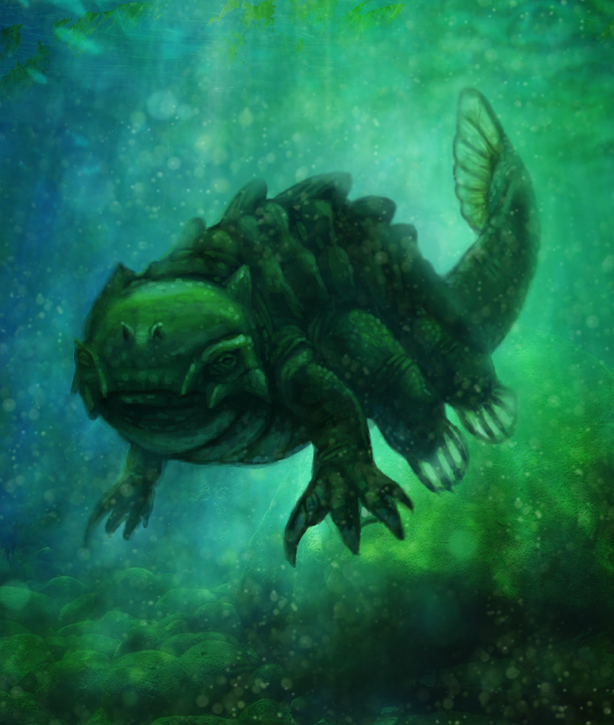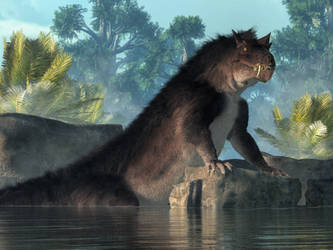ShopDreamUp AI ArtDreamUp
Deviation Actions
Description
I haven't painted much underwater, and I haven't posted any Caranoctia critters in a while, so here's a speedpaint of a snolligoster.
Snolligosters belong to a rather large family of six-limbed pseudoreptiles, including mugwumps and false dragons. They lurk in the streams and rivers of southeastern Caranoctia, where they prose a hazard to livestock and boats.
This is actually the larval form. They begin the size of pug dogs and quickly reach the manatee size shown here. Although they are omnivores which will shove just about anything into their huge, tooth-filled jaws, they prefer to eat meat whenever they can get it. Despite the turbulence of their watery habitat, they are very sensitive to vibration in the water which indicate potential prey, and may actually be able to sense electrical currents, as sharks do.
The heavily built forelimbs are armed with a large claw which is used to spear prey, drag themselves short distances overland (usually on dark, rainy nights) and to anchor themselves to the beds of fast-running streams. Air-breathers, they can absorb some oxygen through the skin of their inner mouths and only need to surface once an hour or so, preferring to remain hidden among the weeds, rubble and boulders. They are normally slow swimmers, propelling themselves with their laterally flattened tails and steering with the four small, sturdy finned limbs, but when properly motivated (usually by food) they exhibit a high turn of speed and can even leap short distances out of the water.
Snolligosters are active during the warm months, but hibernate when winter comes. This allows them to spread further north than other reptiles, where they compete with river cats in the northernmost parts of their range. To prepare for hibernation, they construct a nest of mud, stones, sticks and other debris cemented together by a special sticky substance emitted by glands in their mouth. They build a coffin-like structure at the bottom of a deep river and seal themselves in, literally freezing solid and entering a deathly state for the duration.
Snolligosters remain in their larval aquatic form for up to twenty years, growing and storing calories. One winter, however, some metabolic switch will flip and what emerges from the cocoon is a "river dragon" - the adult stage, an immense yet graceful creature resembling a seahorse. The middle pair of limbs transform into fragile wings and the rear pair into claspers which help it hold on during its midair mating sessions. The jaws have atrophied into a tube-like snout, and most of inner organs are gone as well, because the river dragon's only goal in its new life is to reproduce.
Inflating internal sacs with lighter-than-air gas produced as it devoured its own body, the river dragons lofts into the frigid spring air in search of as many mates as possible. Hermaphrodites, each individual gathers sperm to fertilize its eggs. The mating frenzy is over in a few days as the river dragons slowly leak their lifting gas, become exhausted, and drop back into the river. The larvae hatch a few days later, devour what is left of their parent as their first meal, and wriggle into the water to begin the cycle over again.
Snolligosters belong to a rather large family of six-limbed pseudoreptiles, including mugwumps and false dragons. They lurk in the streams and rivers of southeastern Caranoctia, where they prose a hazard to livestock and boats.
This is actually the larval form. They begin the size of pug dogs and quickly reach the manatee size shown here. Although they are omnivores which will shove just about anything into their huge, tooth-filled jaws, they prefer to eat meat whenever they can get it. Despite the turbulence of their watery habitat, they are very sensitive to vibration in the water which indicate potential prey, and may actually be able to sense electrical currents, as sharks do.
The heavily built forelimbs are armed with a large claw which is used to spear prey, drag themselves short distances overland (usually on dark, rainy nights) and to anchor themselves to the beds of fast-running streams. Air-breathers, they can absorb some oxygen through the skin of their inner mouths and only need to surface once an hour or so, preferring to remain hidden among the weeds, rubble and boulders. They are normally slow swimmers, propelling themselves with their laterally flattened tails and steering with the four small, sturdy finned limbs, but when properly motivated (usually by food) they exhibit a high turn of speed and can even leap short distances out of the water.
Snolligosters are active during the warm months, but hibernate when winter comes. This allows them to spread further north than other reptiles, where they compete with river cats in the northernmost parts of their range. To prepare for hibernation, they construct a nest of mud, stones, sticks and other debris cemented together by a special sticky substance emitted by glands in their mouth. They build a coffin-like structure at the bottom of a deep river and seal themselves in, literally freezing solid and entering a deathly state for the duration.
Snolligosters remain in their larval aquatic form for up to twenty years, growing and storing calories. One winter, however, some metabolic switch will flip and what emerges from the cocoon is a "river dragon" - the adult stage, an immense yet graceful creature resembling a seahorse. The middle pair of limbs transform into fragile wings and the rear pair into claspers which help it hold on during its midair mating sessions. The jaws have atrophied into a tube-like snout, and most of inner organs are gone as well, because the river dragon's only goal in its new life is to reproduce.
Inflating internal sacs with lighter-than-air gas produced as it devoured its own body, the river dragons lofts into the frigid spring air in search of as many mates as possible. Hermaphrodites, each individual gathers sperm to fertilize its eggs. The mating frenzy is over in a few days as the river dragons slowly leak their lifting gas, become exhausted, and drop back into the river. The larvae hatch a few days later, devour what is left of their parent as their first meal, and wriggle into the water to begin the cycle over again.
Image size
614x725px 584.75 KB
© 2012 - 2024 Viergacht
Comments18
Join the community to add your comment. Already a deviant? Log In
i love it!





































